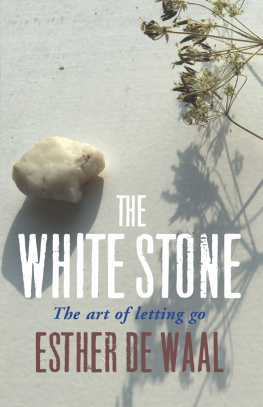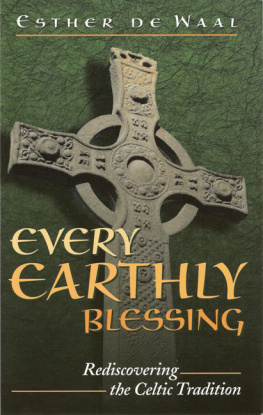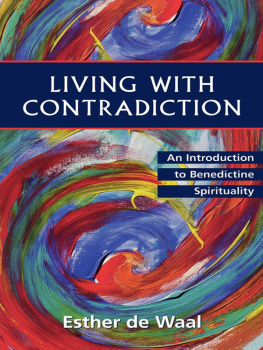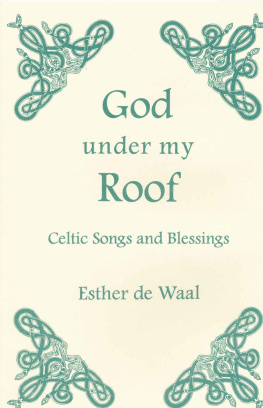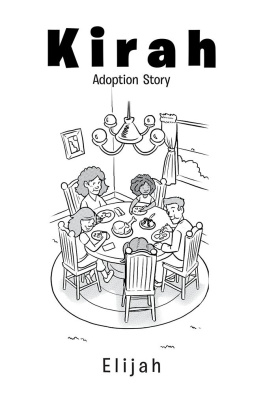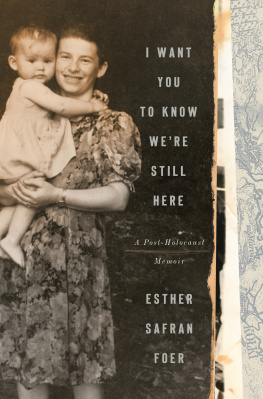Copyright 2021 Esther de Waal
Originally published in the UK under the title
The White Stone
by the Canterbury Press,
an imprint of Hymns Ancient & Modern Ltd of 13a Hellesdon Park Road, Norwich, Norfolk NR6 5DR
Published in the United States of America by
Liturgical Press, Collegeville, Minnesota 56321
All rights reserved. No part of this publication may be reproduced, stored in a retrieval system, or transmitted, in any form or by any means, electronic, mechanical, photocopying or otherwise, without the prior permission of the publisher, Canterbury Press.
The Author has asserted her right under the Copyright, Designs and Patents Act 1988 to be identified as the Author of this Work
Library of Congress Cataloging-in-Publication data available
ISBN 978-0-8146-6789-7
ISBN 978-0-8146-6790-3 (e-book)
for
Theo and Emmy
This small book is a direct outcome of the months spent in lockdown as a result of the pandemic of the years 202021. It is highly personal, a long conversation with myself that those weeks of solitude encouraged. Writing has always been for me a means of exploring my feelings, making sense of my situation. So, I picked up my pen and began to write what became a monologue, as I looked back to the leaving of a place in the Welsh Marches that had meant so much to me over many years, and my arrival in my new home Oxford.
We all have to face up to the process of letting go at intervals throughout our lives, and for everyone the response will be very different. I feel that what I have achieved amounts to little more than hints and glimpses into a vast and vital topic. I hope that this book may encourage others to dialogue with what I have written here.
I owe a deep debt of gratitude to my family for the practical help and moral support over recent years. Among the friends whose stalwart presence has meant much is Claudia Wald. And a very warm mention must go to Pegasus Grange in Oxford and the generosity of its welcome to me.
E de W
20 August 2021
The Feast of St Bernard
Apologia
I slip my hand into my pocket to check if it is still there just a small white stone. I feel its rough edge but I do not need to pull it out, I just need to have the reassurance of its presence. I am walking along a crowded pavement in a busy city, which is at once beautiful and alien. These buildings speak a language new to me no longer the vernacular of cottages and barns, simple, humble churches, small muddy lanes. Here instead one magnificent view succeeds another; this is a city of grand vistas, speaking of the pursuit of wisdom, the search for beauty. William Wordsworth loved its High Street, praising the stream-like windings of that glorious street. Christopher Wren left his mark on the place, as did Nicholas Hawksmoor and many other illustrious names. But there are also the more intimate glimpses, small streets called Turnagain Lane or Catte Street. There are forgotten graves in an out-of-the-way cemetery where one can pay homage to some of the noble figures of university life. The college chapels house incomparable treasures, not least in their stained-glass windows. I am just beginning to learn the roll call of names of the men and women blessed in holiness or learned in scholarship who are remembered here, from the Saxon St Frideswide to the Victorian Lewis Carroll. Each walk I take shows me something new. Every time I come into the city I pass a memorial to Lord Nuffield and I remember that St Aldates was the old Jewish quarter.
There is so much to discover. I am glad that Jan Morris (who was a chorister at Christ Church) should call it partly an ark, partly an argosy. Oxford is like a huge way ward cargo of treasures, shipped home by some eccentric entrepreneur with an eye for a promising talent, plenty of money and stubborn preferences of his own. She allows me to show a little disrespect, which I find reassuring, when she writes: As for the nightmare heads outside the Sheldonian Theatre, it is a moot point whether they represent philosophers, Roman emperors or the 12 apostles. Yet she writes eloquently of that powerful Epstein figure of Lazarus in the ante-chapel of New College, the risen Lazarus still shrouded for the grave, white and tortured, the most haunting statue in Oxford.
I am pleased to see that the Oxford ragwort, or at least a cousin, flourishes on the banks of the rivers Cherwell and Thames, rampant and untidy, bold and splendid, as though making its protest against anything with a hint of grandeur its Latin name after all is senecio squalidus. Its career began here in the seventeenth century when it was imported from either Greece or Sicily, but it escaped and with a preference for gravel or unkempt ground it made its way along the clinker ash of the railway tracks. I find this an enjoyable story. It clambers through some rusty railings on Folly Bridge and the bright yellow catches my eye. Just as I stop there, gazing down at the Thames churning after last nights heavy rain, I hear the sound of Great Tom booming out from Christ Church, mingling with those other chimes of Merton and Magdalen as they succeed one another. I think of the opening lines of Gerard Manley Hopkins:
Duns Scotuss Oxford
Towery city and branchy between towers;
Cuckoo-echoing, bell-swarmed, lark-charmed,
rook-racked, river-rounded;
It was written when he was in Oxford in March 1879 (not when he was an undergraduate at Balliol). And that then reminds me of Jude, in Thomas Hardys Jude the Obscure, as a young man gazing at the distant city of Christ minster when suddenly the wind reaches him and seems like a message from the place: Surely it was the sound of bells, the voice of the city, faint and musical, calling to him, We are happy here!
The stone is still there I check it once again, remembering its origins in a tiny brook in Herefordshire and contrasting it to the majestic Thames. I walk slowly over Folly Bridge wondering about the Franciscan friar Roger Bacon, a leading light of Oxfords thirteenth-century intellectual life was his study really here, in a tower on the bridge? I do not know but I shall find out at the moment, if myth and fact mingle, I can reassure myself that I have time and opportunity to explore the reality of my new landscape.
The Cottage I
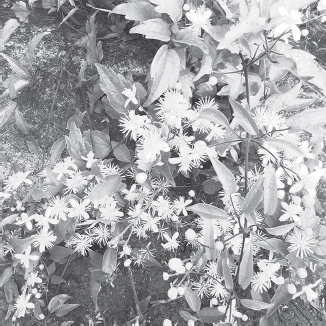
The cottage nestles into the side of a gently sloping hill, it looks as though it is naturally a part of the landscape, not imposed upon it. Its name is Cwm, the Welsh word for a shallow valley. The map of this area of the Welsh Marches shows a scattering of cwms, as common as the local quarries, and this cottage is built of the local Herefordshire red sandstone as are all the nearby farms and barns. My first memory of it is that it was just like a small childs drawing of the perfect house: square, with four windows and two squat chimneys and a porch over the front door. It felt simple and safe, and the great old yew tree growing on one side seemed to bring a sense of timelessness.
Leonard Woolf wrote in his autobiography Beginning Again that, in his experience, What cuts the deepest channels in our lives are the different houses in which we This cottage has brought me that stability, for it has been a continuing presence in my life for over fifty years. Everything about it is familiar and loved. I open the door and go into the kitchen with its red-brown tiles and the kettle singing on the stove. It is a sunny day and the light pours in and plays on the whitewashed walls. The wood of the scrubbed table, the splendid old oak dresser, the shelf of books, the chest for toys, all bring their security, a sense of belonging here welcoming me in. May Sarton, the American novelist and poet, writes about the dear familiar gods of home and the happiness that is daily being woven into a house:

